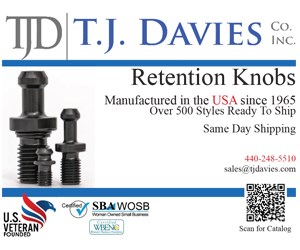Iscar Leader Describes Tool Technology for Machine Shops Acting on Data
As more sophisticated insight into machining performance reveals opportunities for efficiency gain, the value of tooling choices that save time will become increasingly clear.
The promise of Industry 4.0 is great news for the adoption of advanced cutting tools. The reason: In interconnected manufacturing systems in which comprehensive data reveal the performance of the system, the impact of an advanced tool becomes clear.
Jacob Harpaz, president and CEO of IMC, the parent company to cutting tool maker Iscar, repeatedly stressed the connection between Industry 4.0 and cutting tools in a recent day-long series of presentations in which he introduced the many new and upcoming Iscar products to about 600 distributors and other salespeople representing these tools. Iscar organizes an event like this about once every five years, and this year, the move toward data interconnectivity in manufacturing is one the most encouraging developments Mr. Harpaz sees.
Historically, the lack of clarity about manufacturing performance has been the main impediment to shops embracing high-end cutting tools. Tools typically account for just 3 percent of the per-piece production cost of a machined part. However, a tool's price tag is more visible than its benefits. This fact leaves manufacturers frequently pursuing cost-saving steps that have little impact. For example, at 3 percent of unit cost, finding tooling that is one-third less expensive will only cut the per-piece part cost by 1 percent. Something similar is true of tool life: Even doubling tool life will only cut cost per part by 1.5 percent. However, finding tooling that provides for significantly faster machining or reduced non-cutting time enables each unit of machine and labor time to deliver more parts, likely cutting the cost per piece by 10 or 15 percent.
This argument makes sense in the abstract. The problem is, it can be hard to marshal the data to prove this case as it applies to a specific tool in a specific cut. That is where Industry 4.0 comes in. We are moving into a world in which manufacturing systems increasingly do marshal data such as this, and manufacturers increasingly make use of it.
“The companies that are good at collecting, analyzing and acting on data will be the leaders,” Mr. Harpaz says, and he expects Iscar will serve them via tools able to cut faster or reduce setup, along with inventory systems supporting the aim of 24/7 machining. The company’s “Logiq" product introduction aims at this, and “machine intelligently” is the company’s tagline for this idea.
In his talk to Iscar representatives, Mr. Harpaz spoke for the better part of 10 hours to explain many classes of new cutting tool products—too much to summarize. But here are examples of some of the kinds of tooling that will help manufacturers ready to refine their processes within increasingly data-driven shops:
- Exchangeable-head tooling. The company’s Multi-Master line is an example of this. The milling-tool family combines a replaceable carbide tip with a steel shank that remains in place in the machine. Among other benefits, this concept of quickly and repeatably changing the tool’s tip provides a time-saving alternative to solid-carbide tools requiring regrinds and repeated tool setting. Much of the success of this type of tooling is being realized on live-tool turning machines, Mr. Harpaz says. In drilling, Iscar has developed exchangeable-head tooling as small as 4 mm in diameter.
- High-feed mills. The use of high-feed mills is now commonplace, Mr. Harpaz says, to the extent that more conventional tools for milling steel at heavier depths and slower feed rates have become dated. Iscar has expanded its tool offerings available in a high-feed geometry, including a solid ceramic end mill.
- Through-tool coolant delivery. Also seeing expanding application are the tools for various machining operations that deliver coolant at high pressure through the tool to where it can most benefit the cut, often by driving chip evacuation.
- Vibration reduction. Tooling applied at long extensions—for boring, milling, grooving—increasingly features built-in moving counterweights that inhibit vibration for faster and more predictable cutting.
- Tool management. The company has expanded its Matrix line of tool-management systems, offering shops and plants various levels of sophistication for stocking tools and related hardware items, tracking these items, controlling access to them and providing for automatic replenishment as this inventory is used. These systems provide for interconnectivity between the shop and the tool supplier, Mr. Harpaz notes, delivering what is perhaps the most important tool-related benefit of all: the assurance that the shop will have that tool in its possession precisely when the tool is needed.
Related Content
Tips for Designing CNC Programs That Help Operators
The way a G-code program is formatted directly affects the productivity of the CNC people who use them. Design CNC programs that make CNC setup people and operators’ jobs easier.
Read MoreUnderstanding G27, G28, G29 and G30
Take a closer look at these reference position commands.
Read More5 G-Code Tips for Increasing CNC Efficiency
Optimizing G code is a low-cost way to improve CNC efficiency without sacrificing usability and safety.
Read More7 CNC Parameters You Should Know
Parameters tell the CNC every little detail about the specific machine tool being used, and how all CNC features and functions are to be utilized.
Read MoreRead Next
3 Mistakes That Cause CNC Programs to Fail
Despite enhancements to manufacturing technology, there are still issues today that can cause programs to fail. These failures can cause lost time, scrapped parts, damaged machines and even injured operators.
Read MoreThe Cut Scene: The Finer Details of Large-Format Machining
Small details and features can have an outsized impact on large parts, such as Barbco’s collapsible utility drill head.
Read MoreObscure CNC Features That Can Help (or Hurt) You
You cannot begin to take advantage of an available feature if you do not know it exists. Conversely, you will not know how to avoid CNC features that may be detrimental to your process.
Read More
.jpg;width=70;height=70;mode=crop)

























